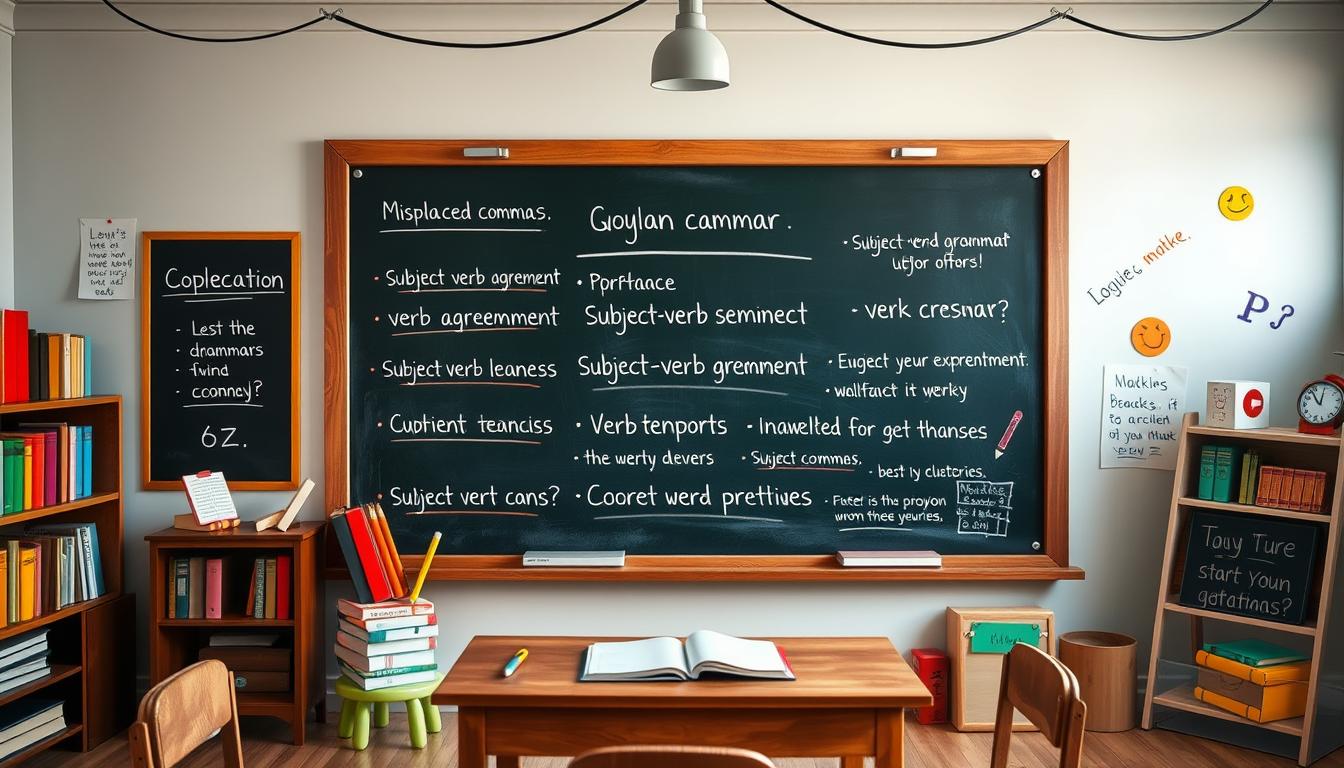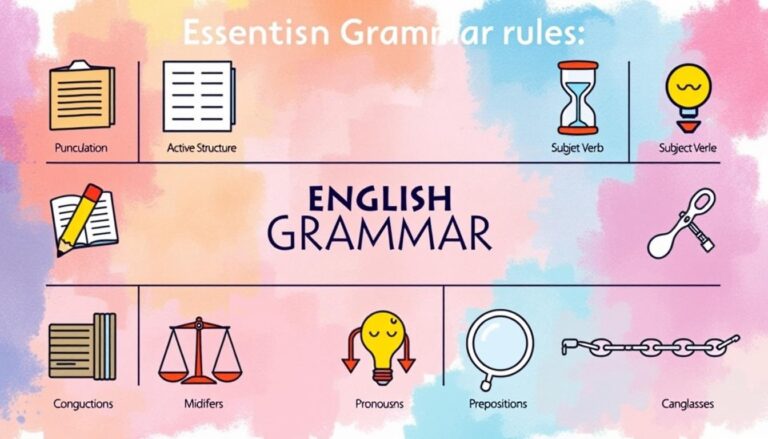Top 10 Basic English Grammar Errors and How to Fix Them
“Clear writing is a reflection of clear thinking.” – George Roberts
Learning to communicate well isn’t about being perfect. It’s about making progress. Whether you’re a student, professional, or someone looking to improve, knowing common grammatical errors can boost your speaking and writing confidence.
Basic English grammar mistakes are more common than you might think. This guide will show you the top 10 most common grammatical errors and offer practical solutions to improve your writing.
Get ready to fix those pesky punctuation mistakes and grammar slip-ups that have been holding you back.
Understanding Basic English Grammar Mistakes That Hold You Back
Let’s explore the most frequent subject-verb agreement errors, pronoun usage problems, and other grammar challenges that can derail your writing.
Common Subject-Verb Agreement Errors
Subject-verb agreement errors can make your writing sound unprofessional. These mistakes occur when the subject and verb don’t match in number. Here are some common situations where writers often go wrong:
🔹 Singular subjects need singular verbs. e
Eg ❌ She go to school every day.
✅ She goes to school every day.
🔹 Plural subjects require plural verbs.
❌ The dogs barks loudly.
✅ The dogs bark loudly.
🔹 When two subjects are joined by “and,” use a plural verb.
❌ My brother and sister is coming to the party.
✅ My brother and sister are coming to the party.
🔹 With “either/or” and “neither/nor,” match the verb to the closest subject.
❌ Either the teacher or the students is responsible for the decorations.
✅ Either the teacher or the students are responsible for the decorations.
❌ Neither the boys nor their coach were happy with the result.
✅ Neither the boys nor their coach was happy with the result.
💡 Pro Tip: Always identify the main subject before choosing the verb!
Problematic Pronoun Usage
Pronouns can create confusion when not used correctly. Pronoun agreement is crucial for clear communication. Watch out for these common pronoun mistakes:
🔹 Mismatched singular and plural pronouns
❌ Each student must bring their own book.
✅ Each student must bring his or her own book.
✅ All students must bring their own books. (Plural subject = plural pronoun)
🔹 Unclear antecedents (unclear reference of pronouns)
❌ When Sarah met Priya, she said she was late. (Who was late?)
✅ When Sarah met Priya, Sarah said she was late.
✅ When Sarah met Priya, Priya mentioned that she was late. (Now it’s clear!)
🔹 Incorrect pronoun case (subject vs. object pronouns)
❌ Me and my friend went to the mall.
✅ My friend and I went to the mall. (“I” is a subject pronoun.)
❌ The gift is for you and I.
✅ The gift is for you and me. (“Me” is an object pronoun.)
💡 Pro Tip: Always match pronouns correctly with their antecedents and choose the right case for clarity!
Verb Tense Consistency Issues
Shifting verb tenses can disorient readers. Maintaining consistent verb tense helps create smooth, coherent writing. Here’s a quick guide to avoiding tense inconsistencies:
❌ I wake up early and went for a run.
✅ I woke up early and went for a run. (Both actions should be in past tense.)
❌ She was cooking when her friend calls her.
✅ She was cooking when her friend called her. (Past continuous should match past simple.)
❌ They finish their homework and went to bed.
✅ They finished their homework and went to bed. (Both verbs should be in past tense.)
❌ He studies for the test and passed it easily.
✅ He studied for the test and passed it easily. (Both actions happened in the past, so the verb tenses should match.)
❌ We were watching a movie when the power goes out.
✅ We were watching a movie when the power went out. (Stick to past tense for past events.)
💡 Pro Tip: To maintain tense consistency, identify the primary tense of your sentence and ensure all verbs align with it. If you’re writing in past tense, keep everything in past tense unless there’s a reason to shift
Double Negative Confusion
Double negatives can muddle your message entirely. In standard English, two negative words typically create a positive meaning. Avoid these tricky constructions to keep your writing clear.
❌ I don’t need no help.
✅ I don’t need any help. (Two negatives here create a positive, making the sentence confusing.)
❌ She can’t hardly wait for the event.
✅ She can hardly wait for the event. (“Can’t hardly” is a double negative, which implies the opposite meaning.)
❌ He isn’t never going to finish his homework.
✅ He is never going to finish his homework. (Double negatives like “isn’t never” should be avoided for clarity.)
💡 Pro Tip: Be mindful when using negatives. If you find two negative words in a sentence, try to rephrase it to keep the meaning clear and avoid confusion.
Apostrophe mistakes
Apostrophe mistakes can confuse even skilled writers. The trick is to know the rules for possessives and contractions. For possessives, remember:
🔹 Singular nouns add ‘s
❌ The cats tail is fluffy.
✅ The cat’s tail is fluffy. (For a singular noun like “cat,” add ‘s to show possession.)
🔹 Plural nouns ending in “s” only add an apostrophe
❌ The dogs bone is chewed up.
✅ The dogs’ bone is chewed up. (For plural nouns like “dogs,” just add an apostrophe after the “s” to show possession.)
🔹 Irregular plurals use ‘s
❌ The childrens toys are scattered everywhere.
✅ The children’s toys are scattered everywhere. (For irregular plurals like “children,” add ‘s to show possession.)
💡 Pro Tip: When showing possession, always check if the noun is singular or plural, and apply the apostrophe rule accordingly. Remember that contractions (like “can’t” or “it’s”) follow different rules, but for possessives, focus on the noun’s number and form.
“Good grammar is not about rules, it’s about clear communication.” – Unknown
Understanding Parallel Structure and Modifiers
Parallel Structure
Parallel structure means using the same grammatical form when listing or comparing things. When the structure is consistent, your writing is easier to follow and sounds smoother.
❌ I like swimming, to run, and reading books.
The verbs are in different forms (swimming = gerund, to run = infinitive, reading = gerund).
✅ I like swimming, running, and reading books.
All items are in the same form—gerunds (verbs ending in -ing).
Misplaced Modifiers
A modifier is a word or phrase that describes or gives more information about another word in the sentence. If a modifier is placed incorrectly, it can make the sentence confusing. A misplaced modifier happens when the word it’s supposed to describe is far away, leading to confusion.
❌ I almost drove the car for six hours.
This implies that the action of “almost driving” for six hours occurred, which doesn’t make sense.
✅ I drove the car for almost six hours.
The modifier “almost” is next to “six hours,” which it is supposed to describe.
Dangling Participles
Participles are verbs used as adjectives, usually ending in -ing or -ed. If the subject isn’t clear, it can lead to confusion or a funny meaning. A dangling participle is a participle phrase that doesn’t clearly modify the word it’s supposed to.
❌ Running to catch the bus, the door slammed in my face.
The sentence makes it sound like the door was running to catch the bus!
✅ Running to catch the bus, I saw the door slam in my face.
Now the participle “Running to catch the bus” clearly refers to the subject “I.”
💡 Pro Tip: For clear writing, ensure parallel structure in your lists, always place modifiers next to the word they describe, and avoid dangling participles by clearly identifying the subject performing the action. This will make your writing more precise and easier to understand.
Capitalization rules
Capitalization rules can be tricky. Always capitalize.
1. The first word of a sentence Example: The cat is sleeping.
2. Proper nouns (names of people, places, etc.) Example: I visited Paris last summer.
3. Titles of books, movies, and other works. Example: I’m reading Harry Potter and the Sorcerer’s Stone.
4. Days of the week and months. Example: My birthday is on Monday, March 15th.
💡 Pro Tip: Practice is essential! By focusing on these capitalization rules, you’ll improve both your writing and speaking skills, making your communication clearer and more effective.Conclusion
Remember – Learning grammar is about making progress, not being perfect. Every small step in improving your language skills boosts your confidence.
The best way to get better at grammar is to keep practicing. Instead of just memorizing rules, try to understand why they work.
Be patient and curious as you learn. With effort, you’ll become more comfortable with English grammar, helping you in both your personal and professional life.







